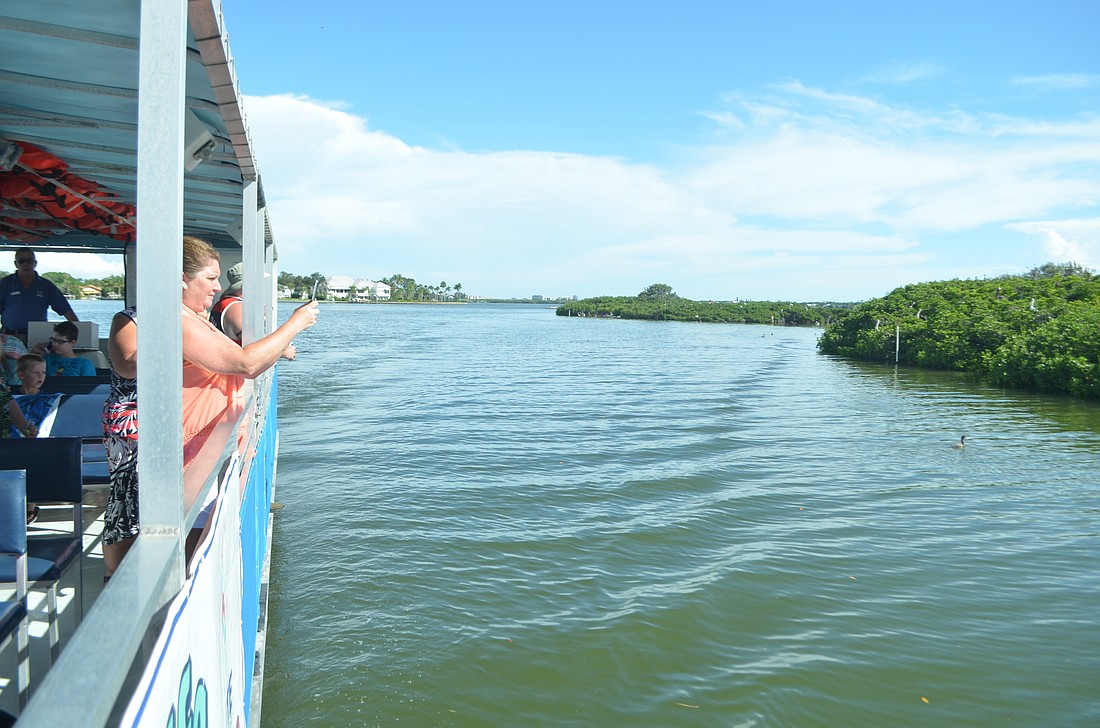- April 19, 2024
-
-
Loading

Loading

Jennifer Lampl stood at the front of a large pontoon boat addressing questions from interested tourists Monday afternoon as the boat idled along the eastern edge of the Roberts Bay Islands.
With birds spotting the mangroves, passengers ooh-ed and ahh-ed as a pelican swooped in to feed its chick.
“We love our birds here in Florida,” Lampl said over the boat’s speakers as it floated under the north bridge to Siesta Key and headed back to Mote Marine Aquarium and Laboratory.
Lampl is the lead biologist for the Sarasota Bay Explorers, which runs nature cruises to the Roberts Bay Islands at least three times a day to see the largest bird rookery in Sarasota Bay.
Fifteen species of birds nest on the islands, some of which are imperiled species, according to the Florida Fish and Wildlife Conservation Commission.
The islands are situated in deep water away from predators and close to food, forming a habitat that is “just right” for nesting.
It’s what Audubon Florida Sanctuary Manager Mark Rachal calls the “Goldilocks effect” — and it’s why the Florida Fish and Wildlife Conservation Commission is pursuing heightened protection for the islands.
The commission is proposing to establish a critical wildlife area on and around the Roberts Bay Islands. The classification is used in areas where education and signage are not effective means to protect bird habitats.
Although the proposals have yet to be reviewed by Florida Fish and Wildlife Conservation commissioners, if passed, a 50- to 100-foot
barrier would be created around the islands, essentially closing them to the public.
Representatives from the commission presented their proposals to Sarasota residents July 20, which were met with unanimous support at a public meeting.
Everyone agreed the islands deserved protection, but there was some debate regarding the distance from the islands at which the boundary should be set.
Sarasota Audubon President Jeanne Dubi believes the commission should err on the side of caution and install the maximum protective radius around the islands to avoid unintended harm to the birds that nest in the mangroves. She’s afraid that boats and fishermen near the islands could cause birds to fly away, possibly leaving their eggs or small chicks behind.
“Most people look at a bird that gets spooked and just sees a bird flying away and don’t understand the consequences of that,” Dubi said.
The Audubon Society runs annual cleanup excursions to the islands and partners with other area organizations, like Sarasota County Schools, to count the number of birds and species living on the islands.
Dubi believes that continuing education and minimizing human contact in the form of boats and fishing is the best way to protect the birds.
But members of the Sarasota Bay Explorers, like Lampl, believe safely increasing people’s awareness of the bird’s habit means a safer environment for the birds. Allowing people to see the islands and the birds that live there is essential, they say.
“We feel that it’s important to educate people through observation,” Lampl said. “It’s a better experience if people can view and see what we’re talking about.”
She would like to see a 50-foot buffer established around the islands so nature cruises can still access the east side of the islands via a small channel. That area would be off-limits if the 100-foot buffer were installed. Lampl believes the 50-foot buffer would be enough to satisfy concerns regarding the safety of the birds.
“Everybody’s happy,” she said. “The birds are happy, the people are happy, and we’re still a safe distance from that habitat.”
Without access to the east side, the Sarasota Bay Explorer boat would cruise along the west side of the islands. Lampl believes that would put the pontoon in dangerous proximity to boats traveling through the Intracoastal Waterway and too far away for visitors to see the birds.
The Florida Fish and Wildlife Conservation Commission is still hearing public comment and assessing where the official boundary will be set. Commission members will likely hear proposals in September, with finalization possible in November.
If commission members finalize proposals in November, the boundary will not be officially installed until fall 2017 to avoid disturbing the birds’ nesting season.
Regardless of the outcome, Lampl said the Sarasota Bay Explorers will abide by the Florida Fish and Wildlife Commission’s ruling, but she’s hoping to continue cruising the east side of islands.
Although Dubi disagrees with that position, she said Sarasota Audubon would be open to partnering with the Sarasota Bay Explorers to provide visitors with binoculars to see the birds.
“We want people to be able to go and visit the islands and see the beauty of nature,” Dubi said. “We would like that to continue, but under safe conditions.”